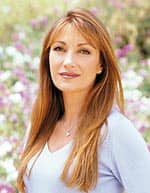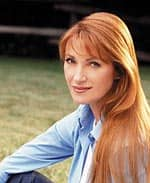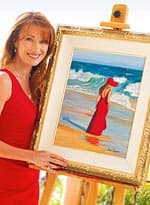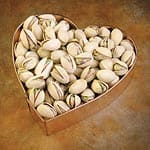Life Extension Magazine®
Jane Seymour is a woman with a passion for life. Her career has encompassed virtually all media forms—from movies and the Broadway stage to books and art—yet she has no intention of slowing down as the years progress. In fact, Jane seems energized by the many opportunities that lie ahead, including her participation in The Heart Truth, a national campaign to raise women’s awareness of heart disease. As part of this campaign, Jane is teaming with the California Pistachio Commission to create “Art for the Heart,” four original, heart-inspired paintings by Seymour that are being sold as limited-edition note cards to support women’s heart health initiatives nationwide and bring attention to the ongoing problem of heart disease in women. Born in Hillingdon, England, and raised in Wimbledon by a British obstetrician and his Dutch wife, Jane began training in dance at an early age, and was just 13 when she made her professional debut with the London Festival Ballet. That same year, she entered the Arts Educational for dance, music, and theater training, and danced with the visiting Kirov Ballet. After suffering an injury, she turned to acting, first appearing in Richard Attenborough’s Oh, What a Lovely War, and shortly thereafter portraying Solitaire in the popular James Bond film, Live and Let Die. Catapulted to stardom by this role, she has since played many different characters, including the title role in the popular television drama, Dr. Quinn: Medicine Woman. Not one to rest on her laurels, Jane continues to star in projects for the small and big screen, including the upcoming movie, The Blind Guy. She will no doubt be a creative force for years to come. Life Extension recently caught up with Jane at a Beverly Hills bistro, where the conversation quickly turned to heart health and longevity. Life Extension: Your career has spanned so many artistic forms. Is there a particular medium you like the best? Jane Seymour: I like each medium for its own reasons. There is nothing like being live in front of an audience, but film is great, too, because you can do multiple takes and have enough budget to get things right. TV is also good because it allows you to reach a wider audience. All in all, film is best because you can do things properly. LE: Tell us about your latest project. How is it different from others you’ve done?
JS: My latest film, The Blind Guy, is about a kid born blind who is attempting to find love. I play a comedic psychologist who helps the kid when he falls in love with an East Indian girl. It’s a wonderful script that is different from anything else out there. It’s good to be playing comedy again, but I look very different than I normally look. It’s definitely a character role. LE: One of your most notable roles, Dr. Quinn, was very popular because it speaks to the importance of family. What are your views about different generations working together for a common goal? JS: One of the plusses of the Dr. Quinn show was that it showed how every generation has its own role. This concept seems to be lost for many people in society today, who see older people as redundant. Every generation needs to realize how valuable each person is and how fortunate we all are to have each other. Each individual offers special thoughts and experiences, and everyone needs to realize that. The show discussed contemporary issues set in the 1870s. These issues are still valid today. LE: You’ve been so active with your books and charitable events that I doubt you will ever retire in the traditional sense. What are your views on longevity and the need to stay active? JS: My role model is my mother, who is 90 years old. She would still be running a business if she had the chance, but she has macular degeneration and arthritis, so she is unable to. Still, she goes to the cinema and is always helping other people. She is so full of compassion. She believes that you need to get involved and stay involved. We both believe that the older you get, the more you have to offer society—not less. LE: Your commitment to fighting heart disease in women is commendable. Why did you choose to become involved in women’s heart issues? JS: Once I found out what the statistics are on women and heart disease, I had to become involved. Heart disease is the number-one killer of women. In 2002, 51% of the deaths from this disease were women. I was also astounded to learn that more than six times as many women die from heart disease than from breast cancer each year, even though breast cancer gets most of the publicity. As a woman, daughter, sister, and mother of two girls, I realized how this issue could easily touch my own life. Getting involved was the next logical step. LE: Tell us about The Heart Truth and what it does to educate women about heart disease. JS: The Heart Truth is a public awareness campaign by the National Heart, Lung, and Blood Institute, which is part of the National Institutes of Health. The campaign’s goal is to reduce the level of misunderstanding among women about what causes heart disease. For example, a recent survey found that many people believe as much as 50% of heart disease occurs in persons who don’t have any of the traditional risk factors for it, such as cigarette smoking, high blood pressure, high blood cholesterol, obesity, physical inactivity, and diabetes. In fact, 95% of those who die from heart disease have at least one risk factor. One of the main awareness-building measures of this campaign is using the red dress as a symbol, along with the slogan, “heart disease doesn’t care what you wear.” On National Wear Red Day, held the first Friday of February each year, women and men across the country unite to give women an urgent wake-up call about their risk of heart disease. As a corporate partner of The Heart Truth, the California Pistachio Commission has been promoting these goals by providing consumers with facts about eating well. They also approached me last year to do a campaign to raise the awareness of heart disease among women. So far I have done four paintings that were lithographed on note cards and sold to raise money for woman’s heart health education. The paintings include Red Tulips in a Clear Vase, Woman in a Red Dress, Portrait of a Red Rose, and Self-Portrait in Red. This was a great match for me, since I love to paint and wanted to make a personal contribution. Next year, I plan to paint more card designs for the commission.
| |||||
| LE: What is your diet like? JS: My meals are heart healthy. I love berries and other antioxidant-rich foods. Berries contain phytonutrients that help with a variety of age-related health conditions. Also, the antioxidants they contain help to prevent the oxidation of cholesterol, making it less likely to stick to the walls of your arteries and promote atherosclerosis. My family grows organic food at home, so we always have fresh fruits and vegetables grown without pesticides. I rarely eat red meat; it’s usually chicken or fish with lots of veggies. I try to keep my sodium intake low, too. Once in a while I’ll indulge, but even then it’s in moderation. I also eat lots of nuts, especially pistachios.
LE: What’s so special about pistachios? JS: Pistachios are actually a very healthy nut. They contain predominantly monounsaturated fat as well as polyunsaturated fat, which fits in well with a heart-healthy diet. They are high in omega-6 fatty acids and low in saturated fat. Pistachios are cholesterol free and have significant amounts of magnesium and arginine, which may help to lower blood pressure, and a high level of beta-sitosterol, which can help lower cholesterol. They are also a good source of fiber. My children and I eat them often for a healthy snack. LE: Do you exercise regularly? What role does this play in heart health? JS: I exercise when I can, but I had back surgery a while back, so I have to be careful. I love to walk at a fast pace, and I also do Pilates, stretching, weights, and isometric movements. Exercise is very important for heart health. You don’t need fancy machines—just make exercise a part of your life. I’m constantly moving and it keeps my heart healthy. There are plenty of studies showing that exercise improves cholesterol profiles, and it keeps your blood pressure in check, too. If only more people would commit to even a modest exercise program, it would really put a dent in the heart disease epidemic. LE: If you had to pick the top three ways to prevent heart disease in women, what would they be? JS: Nutrition, aerobic exercise, and monitoring your condition so you can correct minor things before they become more serious. Good nutrition is essential for maintaining the health of your cardiovascular system. Fatty fish such as salmon are rich in omega-3 fatty acids, which reduce inflammation and help to improve your blood pressure and cholesterol profile. Olives contain high levels of monounsaturated fats that promote heart health. And, of course, you need a full spectrum of vitamins and minerals to ensure that your body gets enough antioxidants and other nutrients to fight free radicals and maximize your immune system.
Even if you don’t have heart disease, good nutrition and exercise will help you. Stress is also a huge factor in the health of your heart. Traditionally, it was believed that men had more stress, but like many women today, I have a career, plus I’m a mother and wife, so I have three stresses. Often women are more stressed than men because of these multiple responsibilities. LE: Nuts were once considered bad for the heart because of their fat content. Now we know that they’re good for the heart. What other myths are getting in the way of heart health for women? JS: There are a lot of myths out there about heart health. You need to address the fact that obesity affects your heart, and if you tax the organ too much with excess body weight, you may die sooner. Your body is like a car—if you take good care of it, it will last longer. So make sure that your body is running smoothly, and don’t put bad things into it. I believe that everything in moderation works well. While you have to watch the salt content, nuts contain good fats, and they taste great. It’s good to get kids into eating them—they are much healthier than candy. LE: The traditional English diet is no more heart healthy than the traditional American diet. What was it like growing up with those foods? Are dietary habits changing in your native England? JS: I grew up eating lots of Dutch food. It was heavy on the cheese, along with bread fried in bacon fat. But change is happening in Europe as well as in this country. I have tried to educate my children, and now they prefer whole-wheat bread to white bread. Also, they get plenty of fiber from fresh fruits and vegetables.
LE: Your efforts to promote heart health are laudable, but one person can only do so much. What needs to happen at the national level to fight this killer disease? Are new guidelines necessary? JS: Education is the most important thing. Everyone needs to address hypertension and the root causes of heart disease. You should check the condition of your arteries and your blood pressure on a regular basis. Also, you have to be proactive. Lifestyle choices are important. I am a firm believer in complementary medicine and I do alternative things as well, but you need to go to your doctor on a regular basis to monitor your health. Sometimes drugs are necessary, but you also need to live healthy. We don’t need more laws, we just have to educate people to eat and live right. Many people are choosing to eat things that are bad for them. We need to educate young people so they know what to do. Kids need to be taught that some foods are poison. An occasional splurge is okay, but once people realize that other options are healthier, their tastes often change for the better. Let’s face it: the drug companies control so much of what is going on, and they do it for their own profit. But when people are educated and are proactive, they won’t need to go to the doctor as often and take expensive drugs. LE: Given the many films and other projects you’ve done, you must be getting on in years, yet you look so young. What are your “secrets” for fighting aging? JS: You need to have a passion for doing things; you can’t be a quitter. There are still lots of things that I want to learn and try. With luck, I will manage to do a few of them. Don’t spend your time thinking about what used to be. You can’t fear the future, either. I live my life in the present tense. I appreciate the fact that I can work, remember my lines, create things, and help my children. My attitude is that you should focus on what you can do, not on what you can’t. LE: You recently exhibited your paintings. What inspires you to paint? With your busy schedule, when do you find time to paint? JS: I literally paint from the heart. It is my meditation, my joy and passion. Initially, it was something private that I did for myself, but then people saw my paintings and wanted to buy them. Now I’ve raised lots of money for charity with them. It is the most consistent work that I do. I participate in at least 12 art shows a year. So while it started as a personal endeavor, it’s now a major part of my career. I’ve been known to bring watercolors wherever I go. I make time for painting, and I often have watercolors in my handbag, so I can paint at any time. LE: With your attention to health and fitness, you’ll no doubt lead a long life. What new challenges or horizons do you hope to explore? JS: Every day I’m challenged to do something new. I’m convinced that I will be active—and no doubt painting—until the end of my days. I’m constantly inspired to learn new things and try something different. That’s the joy of art and the creative process—it’s a never-ending project. LE: Are you ready to live to be 100? JS: I’m definitely ready to live to be 100. I’d like to die healthy, of course, and die happy, knowing that I did the things I wanted to do with the time I had. For more information, visit www.hearttruth.gov, www.pistachio.org, www.nutrition.gov, www.janeseymour.com, and www.cdc.gov. |




